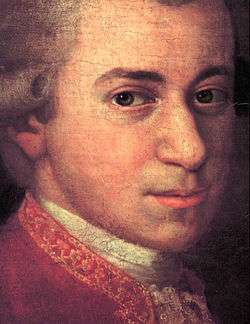Rondo for Piano and Orchestra in A major (Mozart)
The Rondo for Piano and Orchestra in A major, K. 386 is a concert rondo by Wolfgang Amadeus Mozart, believed by Alfred Einstein to have been composed in late 1782.[1]
Composition
Mozart wrote the Rondo in A major at around the same time as his three first Vienna piano concertos, nos. 11, 12 and 13.
It was once believed that Mozart left this piece unfinished,[2] because when Constanze Mozart sold the manuscript in 1799 to J. A. André, the concluding pages were missing. However, Alan Tyson discovered the previously-missing conclusion in the British Library in 1980.[3] Before this, the rest of the autograph had been dismembered and scattered, and the only known version that was complete was Cipriani Potter's piano arrangement from about 1838. Alfred Einstein, using this and only 2 then-known leaves of the score, published a reconstruction of the rondo in 1936, and further leaves that came to light were reflected in the Neue Mozart-Ausgabe and a 1962 completion by Paul Badura-Skoda and Charles Mackerras.[1] The final leaves discovered by Tyson have now been incorporated into most recent recordings of the rondo, such as those of Murray Perahia and Malcolm Bilson.
Possible Intentions
The musicologist Alfred Einstein believed that the piece was intended as either the original or a replacement finale for his Piano Concerto No. 12 in A.[1] Both pieces are in the same key, and both were composed at similar times. However, there are considerable differences. The three concertos were composed by Mozart to be a quattro (with just four strings in accompaniment), whilst the Rondo cannot be, as the cellos have an independent line from the basses.[4] The first page of the manuscript was also titled and dated by Mozart, suggesting individuality.[1]
Description
The Rondo is marked allegretto,[2] giving the piece a lively but unhurried feel. The piece is begun, as with much of Mozart's concerto work, by the strings, who play the piece's main theme. Again typical of the beginning of Mozart's piano and orchestral works, the piano only enters after about a minute of orchestral playing. It too plays the main theme, but in a very intimate and graceful manner. A second theme then follows, and mixes frivolous, playful elements with introspective, dreamier sections. The original theme then repeats, to be followed by another different melody. This melody is more imposing and serious than its precursors, until it wonderfully leads back into the original melody. The piece finishes with a coda in true rondo form to give an A-B-A-C-A-D structure. The piece lasts between 8 and 10 minutes, depending on how it is completed.
References
- Notes
- 1 2 3 4 Pajot, Dennis. "K386 Rondo for Piano and Orchestra in A". mozartforum.com. Retrieved 13 September 2016.
- 1 2 Cummings, Robert (2016). "Wolfgang Amadeus Mozart: Rondo for piano & orchestra in A major, K. 386". Allmusic.com. Retrieved 13 September 2016.
- ↑ Tyson 1987, pp. 262-289
- ↑ Philips Digital Classics 'Complete Mozart Edition- Piano Concertos'; Label Number 464 800-2.
- Sources
- Tyson, Alan (1987). Mozart: Studies of the Autograph Scores. Cambridge, MA: Harvard University Press. ISBN 0-674-58831-2.
External links
- Rondo in A KV 386: Score and critical report (German) in the Neue Mozart-Ausgabe
- Rondo in A, K. 386: Scores at the International Music Score Library Project
- "Rondo in A major, K. 386 performed by Gaspare Spontini Philharmony Orchestra". YouTube. 8 May 2013.
